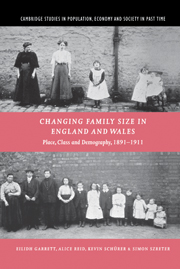Book contents
- Frontmatter
- Contents
- List of figures
- List of tables
- Preface and acknowledgements
- 1 Introduction
- 2 Locations for study
- 3 Studying locations
- 4 Infant and child mortality from the 1911 census
- 5 Fertility and fertility behaviour 1891–1911
- 6 The national picture
- 7 Class, place and demography: the mosaic of demographic change in England and Wales from Waterloo to the Great War
- Appendices
- References
- Index
- Cambridge Studies in Population, Economy and Society in Past Time
3 - Studying locations
Published online by Cambridge University Press: 05 January 2010
- Frontmatter
- Contents
- List of figures
- List of tables
- Preface and acknowledgements
- 1 Introduction
- 2 Locations for study
- 3 Studying locations
- 4 Infant and child mortality from the 1911 census
- 5 Fertility and fertility behaviour 1891–1911
- 6 The national picture
- 7 Class, place and demography: the mosaic of demographic change in England and Wales from Waterloo to the Great War
- Appendices
- References
- Index
- Cambridge Studies in Population, Economy and Society in Past Time
Summary
From census enumerators' books to data files
Once the enumeration district clusters or sectors chosen to represent each of the 13 locales in each census year had been identified, the information recorded in the relevant enumerators' returns had to be converted into computerised data files.
The transcription of the returns to magnetic tape was carried out by OPCS to maintain the confidentiality of the original material. Names and addresses were not transcribed so that anonymity was provided, but otherwise the files were as far as practically possible a faithful transcription of the original returns.
The files brought with them two sets of problems which had to be addressed before analysis could proceed. The first set of difficulties were those created by the census-taking process itself, while the second set were encountered when transforming the transcribed records into an analysable dataset. The present section deals with the latter set first, outlining the pitfalls faced and the remedies adopted. Sections 3.2 and 3.3 then address the issues arising from the changing nature of the census-taking process and procedures, before sections 3.4 and 3.5 lay out the analytical concepts and expediencies utilised within the research framework in order to overcome the constraints of the data.
On receipt of the data tapes a series of checks verifying the accuracy of the source material and of the transcription was carried out, and amendments were made to the files where necessary. Then, in order to facilitate subsequent analyses, most of the fields of information within the data files were systematically coded.
- Type
- Chapter
- Information
- Changing Family Size in England and WalesPlace, Class and Demography, 1891–1911, pp. 56 - 104Publisher: Cambridge University PressPrint publication year: 2001

